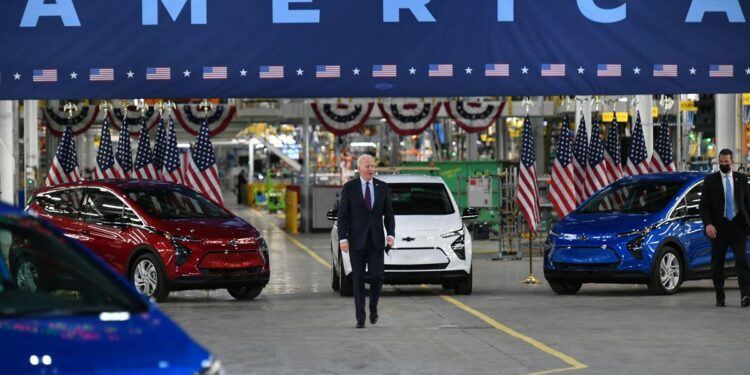Earlier this month the Biden administration released a plan to build a network of 500,000 electric vehicle charging stations across the country. President Biden considers this an essential part of the fight against climate change by enabling the continued rollout of electric vehicles.
In announcing the plan, Vice President Kamala Harris noted, “When we ask people what is the biggest barrier for them to buy an electric car, the answer is almost always figuring out where and how to charge it”.
The plan emphasizes standardization as the charging network expands from the current patchwork of 100,000 public charging outlets. EV owners are well aware of the challenges of navigating the current fractured EV charging network, which have different outlets, payment options, and hardware hookups.
President Biden had sought $15 billion for the plan, but Congress cut that amount in half in the recently-passed infrastructure bill. Nevertheless, the Administration has stuck to the original plan, with $5 billion deployed to states, territories and the District of Columbia. The remaining $2.5 billion will be targeted at putting charging stations in rural areas.
Faster Charging Required
Fast chargers are needed, because the amount of time it takes to charge a vehicle is another factor influencing the decision to purchase an electric vehicle. But the reduced funding likely means more slower charging stations.
Level 2 charging stations require 2-10 hours to fully recharge a depleted battery. Higher power and more expensive Level 3 charging stations can achieve this in 30 minutes. This means most EV customers will likely need to do most of their charging overnight at home.
But the faster Level 3 charging stations will need to be strategically located along major highways and interstates to serve drivers on long-distance trips – a necessity especially if EVs are to play a larger role in commercial transportation. Presently there are vast stretches of EV deserts across the U.S. Midwest and South, and that is a major hindrance for those wanting to buy an EV.
A Strain on the Grid
Beyond the charging speed, a massive buildout in EV charging capacity will require more power and more grid capacity to supply them. The International Energy Agency (IEA) has estimated that by 2030 EVs could require between 525 terawatt-hours (TWh) and 860 TWh of electricity globally, up from 80 TWh last year. This is equivalent to more than three times the current power consumption of California.
The California state government is facing a formidable challenge, given its increasing reliance on renewables while facing extreme climate conditions that severely strain the grid. Current rates of new power plant commissioning are slower than what would be needed to achieve 100 percent clean energy by 2045, as set out by the California Energy Commission, while not all power plants newly in operation are using clean resources. A case in point are the temporary gas plants to avoid blackouts during summer.
Innovative Solutions are Coming
Even so, California – home to nearly half of all EVs in the U.S. – is at the forefront of vehicle-grid integration. The state intends to stop selling gasoline-powered passenger cars by 2035, so it has launched a number of initiatives to ensure that EVs don’t overwhelm the state’s electric utility infrastructure.
Southern California Edison has launched a $436 million program to install 38,000 electric car chargers over the next five years. The program will incentivize smart charging during the day when solar energy is at its peak, and power is cheapest as a result.
But there are other innovative solutions being developed by several start-ups, which could help. L-Charge, for example, has developed a charging station that’s off the grid entirely and can charge 100 km (roughly 60 miles) in just 5-10 minutes. The company has developed both a stationary and mobile version of its chargers. The stationary version can be located in conventional locations, but the mobile version can actually travel around a city and charge vehicles on demand.
Meanwhile, Amazon-backed startup Span has developed a smart electrical panel, capable of being paired with a Level 2 EV charger. Span panel can be paired with Amazon’s voice recognition interface, Alexa. This integration will make it easier for homeowners to identify the largest power users in the home at any given time. In turn, that could help balance the energy load and charge EVs only when there’s spare electricity capacity.
In many areas, tapping into the grid means charging an EV with fossil fuel-generated power. But the mobile charging station developed by L-Charge, which runs on relatively low-emission liquefied natural gas (LNG) or hydrogen, also offers a solution that doesn’t involve additional strain on the grid. This is an important innovation in a world in which demands on the grid are expected to grow rapidly over the next decade.
In the long run, electric vehicles may both accelerate the shift to renewable energy and help stabilize the grid. Many homeowners will increasingly rely on solar power they generate themselves to charge their EVs, and this could displace significant fossil fuel power sources over the next decade.
But if this transition is going to proceed on an aggressive schedule, the Biden administration’s plan will need to be supplemented by investment in faster-charging stations and in bolstering the electrical grid or developing off-grid solutions.











